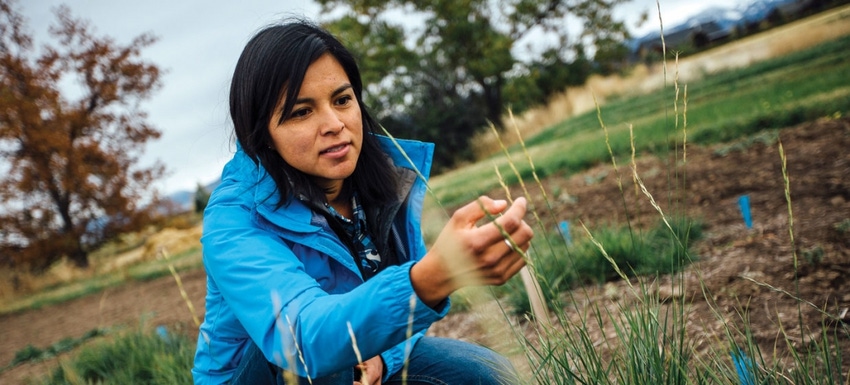Grant seeks to increase participation of women in ag science
While women constitute less than 1% of nation’s agricultural scientists, engineers and policy-makers, they occupy about 60% of lower-paid agricultural jobs.
January 12, 2018

Data from the U.S. Bureau of Statistics and U.S. Department of Agriculture show that while women constitute less than 1% of the nation’s agricultural scientists, engineers and policy-makers, they occupy the majority, about 60%, of lower-paid agricultural jobs on America’s farms and ranches.
Six female professors at Montana State University and Flathead Valley Community College (FVCC) in Montana hope to increase the percentage of female agricultural scientists, engineers and policy-makers by way of a $94,000 USDA National Institute of Food & Agriculture grant, “Empowering Women in Agriculture.”
The grant is funded by the USDA National Institute of Food & Agriculture’s Women & Minorities in Science, Technology, Engineering & Mathematics Fields Program, a federal initiative that invests in a diverse, 21st-century agricultural science workforce and aims to increase representation of women and minorities in American agriculture.
“Representation and participation by women is an incredibly important focus in 21st-century agriculture,” said Irene Grimberg, Montana State professor of cell biology and neuroscience in the College of Letters & Science and one of the grant’s six principal investigators. “It’s a privilege to administer the grant with my colleagues so that we can begin to explore how we can elevate and support a diversified agricultural workforce in Montana.”
In 2015, USDA published a jobs report in the food, agriculture, renewable natural resources and environmental sectors. The report’s strongest career projections are in agricultural science, technology, engineering and mathematics (STEM) fields, sustainable food and biomaterials. The report also cited a need to diversify America’s agricultural workforce, the announcement from Montana State said.
According to project organizers, the central goals of the grant are threefold: (1) integrate research and education to increase the participation of women in agriculture, (2) prepare the next generation of agricultural leaders in Montana and (3) bring greater public awareness to the critical role of females in agriculture. According to USDA, 34% of Montana farmers, or 15,065, are women.
The grant’s five other principal investigators are Tracy Sterling, head of the department of land resources and environmental sciences at Montana State; Tracy Dougher, associate dean of the Montana State College of Agriculture; Jane Mangold and Lisa Rew, associate professors in the department of land resources and environmental sciences who focus on a wide variety of weed and invasive plant ecology and management issues in range and agricultural systems, and Heather Estrada, associate professor and program director of agriculture at FVCC.
The grant’s investigators will provide a two-credit online course, “Women in the Agricultural Workforce in the 21st Century,” that targets freshman and sophomore students enrolled at institutions in the Montana University System. The course will be team-taught by Estrada, Rew and Mangold.
Estrada said the course will highlight the diversity of roles and contributions made by women currently working in agricultural careers in farming and ranching, research, extension, administration and marketing.
“The idea is to expose students to the incredible variety of agricultural workforce pathways and their associated rewards and demands shared by women working in diverse roles in Montana agriculture,” Estrada said. “There are many career opportunities for young women besides production that don’t require farming or ranching background. When we developed the class, we wanted to facilitate communication between an older generation of seasoned professionals in agriculture and the current, or next, generation of women in agriculture for an opportunity to connect and empower each other.”
Agriculture is a very male-dominated STEM field, Estrada said, adding, “The more we can explore and recognize the wonderful and diverse contributions of women in agriculture, the more we can think outside the box and find opportunities to contribute.”
The partnership between Montana State and FVCC is particularly important, Sterling said, because it's sharing resources in a rural, agricultural state, and it targets historically underrepresented students: those first-generation college students, American Indian students and non-traditional students who typically enroll in community colleges or two-year workforce programs, the announcement said.
Sterling, who managed New Mexico State University’s ADVANCE grant funded by the National Science Foundation, said the ADVANCE and USDA programs share similar tenets of inclusion and support of women in higher education.
“Gender equity and diversity are certainly not new issues,” she said. “However, they become increasingly important as we see several fields where there’s a small percentage or complete absence of women at the top levels of administration and management, especially in STEM fields.”
A second aspect of the grant is a statewide survey of Montana women who work in agriculture. Grimberg said the survey seeks to identify the female workers’ needs, aspirations and achievements. The survey questions focus on pay inequity, women in leadership roles, entrepreneurial support, workplace characteristics, land and capital access and principal roles in agriculture.
“The survey study is intended to gauge women’s dreams, aspirations and expectations, in addition to their needs,” Grimberg said. “We don’t know what kinds of research, programs and tools are needed to better support Montana women in agriculture unless we have some baseline data.”
In a culminating event, the grant’s project leaders plan to organize a two-day public summit of women in agriculture to be hosted at Montana State that will include panels, student presentations, talks and discussions on women’s experiences in agriculture.
Charles Boyer, Montana State vice president of agriculture, said he’s thrilled to support the grant and its goal of diversifying the agricultural workforce.
“As we look to a robust 21st-century ag workforce that can meet the demands of global food security and safety through technology and science, we need to uplift, mentor and support every resource possible. That begins with women and minority populations,” Boyer said. “My hope is that Montana students from diverse backgrounds seriously consider the agricultural fields. We need them.”
You May Also Like


.png?width=300&auto=webp&quality=80&disable=upscale)
